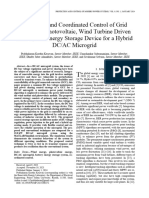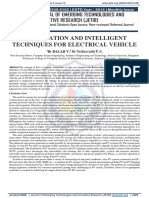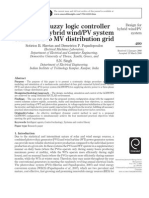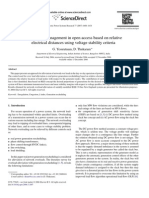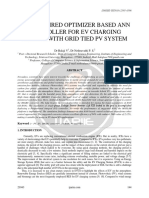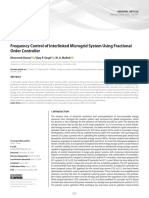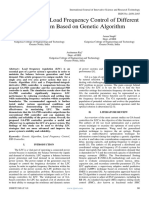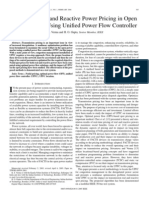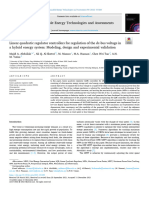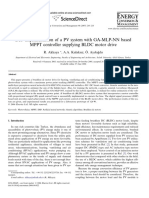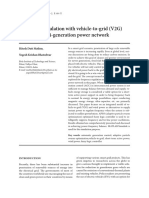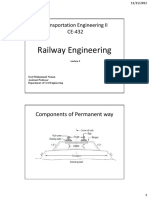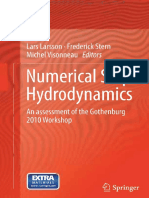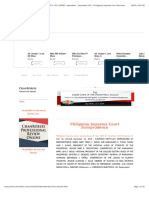Model Predictive Control of Plug-In Hybrid Electric Vehicles For Frequency Regulation in A Smart Grid
Model Predictive Control of Plug-In Hybrid Electric Vehicles For Frequency Regulation in A Smart Grid
Uploaded by
mahmoud helalCopyright:
Available Formats
Model Predictive Control of Plug-In Hybrid Electric Vehicles For Frequency Regulation in A Smart Grid
Model Predictive Control of Plug-In Hybrid Electric Vehicles For Frequency Regulation in A Smart Grid
Uploaded by
mahmoud helalOriginal Title
Copyright
Available Formats
Share this document
Did you find this document useful?
Is this content inappropriate?
Copyright:
Available Formats
Model Predictive Control of Plug-In Hybrid Electric Vehicles For Frequency Regulation in A Smart Grid
Model Predictive Control of Plug-In Hybrid Electric Vehicles For Frequency Regulation in A Smart Grid
Uploaded by
mahmoud helalCopyright:
Available Formats
IET Generation, Transmission & Distribution
Research Article
Model predictive control of plug-in hybrid ISSN 1751-8687
Received on 26th December 2016
Revised 28th February 2017
electric vehicles for frequency regulation in a Accepted on 20th March 2017
doi: 10.1049/iet-gtd.2016.2120
smart grid www.ietdl.org
M. Elsisi1 , Mahmoud Soliman1, Magdy A.S. Aboelela2, W. Mansour1
1Electrical Power and Machines Department, Faculty of Engineering (Shoubra), Benha University, 108 Shoubra St., P.O. Box 11241, Cairo,
Egypt
2Electrical Power and Machines Department, Faculty of Engineering, Cairo University, P.O. Box 12613, Giza, Egypt
E-mail: mahmoud.elsesy@feng.bu.edu.eg
Abstract: Integration between energy storage systems and renewable energy sources (RESs) can effectively smooth natural
fluctuations of the latter and ensure better frequency regulation. Optimal performance of the plug-in hybrid electric vehicle
(PEHV) battery, having longer plug-in than driving time, makes it a good candidate for integration with RESs. Decentralised
model predictive control (MPC) is proposed here for frequency regulation in a smart three-area interconnected power system
comprising PHEVs. Two MPCs in each area are considered to manipulate the input signals of the governor and PHEV in order
to tolerate frequency perturbations subject to load disturbances and RES fluctuations. Setting the parameters of the six MPC
controllers is carried out simultaneously based on imperialist competitive algorithm (ICA) and bat-inspired algorithm (BIA). Time-
domain based objective function is suggested to account for system non-linearities emanating from governor dead bands and
turbine generation rate constraints. The proposed tuning procedures utilising ICA and BIA are completely accomplished off-line.
Comparative simulation results are presented to confirm the effectiveness of the proposed design.
1 Introduction constraint in [17]. The researchers in [18] presented MPC with
LFC but not deal with the change of system's parameters and
Exhausts of traditional power plants that depend on fossil fuels are generation rate constraint (GRC). In order to get better
considered the most problem that worries the world. Therefore, performance using MPC, its parameters must be designed by an
many researchers directed their research towards the existence of appropriate method. This paper proposes two artificial intelligence
alternatives to resolve this issue. The renewable energy sources (AI) techniques named imperialist competitive algorithm (ICA)
(RESs) represent the most important of these alternative and bat-inspired algorithm (BIA) for the optimisation of MPC
approaches. These energy sources are clean and renewable but parameters in coordination with PHEV to frequency control in a
intermittent [1]. The fluctuation of these renewable energies can non-linear three-area interconnected hydrothermal system
lead to unbalanced grid frequency [2]. Due to these intermittent including RES. The considered system includes the GRC and the
RES, large-scale battery storage system has become an important governor dead band. The results of the proposed design are
part of ensuring grid frequency stability. The lithium battery of the compared with ICA-based MPC and the conventional PI controller-
plug-in hybrid electric vehicle (PHEV) has a high energy density based Ziegler–Nichols (ZN) technique [19] without PHEV.
and slow discharge when it is not in use [3]. This high performance This paper is organised as follows: In Section 2, power system
and the bi-directional charging and discharging power control of overview. The PHEV model is described in Section 3. MPC
PHEV make it widely used in smart grids to reduce unwanted modelling is illustrated in Section 4. ICA and BIA overview is
fluctuations in the output frequency from the discontinuity presented in Section 5. In Section 6, the simulation results are
renewable energy. Furthermore, the PHEVs will be used presented. Finally, the conclusions are provided in Section 7.
extensively in consumer side for driving because of low-cost
charging, reduced petroleum usages, and reduced greenhouse
emissions [4]. PHEV is equipped with various control methods of 2 Power system overview
load frequency control (LFC) such as a conventional proportional– The modern power system or the smart grid contains RES as
integral (PI) controller [5, 6], a robust PI controller [7], an adaptive shown in Fig. 1. The fluctuation of RES leads to change in grid
control [8], a fuzzy control [9], a coefficient diagram method [10], frequency from the nominal value. The governors of the thermal
and a model predictive control (MPC) [11–14]. In [11], the weights and hydro turbine are no longer sufficient to compensate these
of MPC for PHEV controller are found by a particle swarm fluctuations of power and frequency due to their slow response.
optimisation (PSO). Also, the MPC weights are tuned by PSO in The smart charging of PHEV presents many challenges to
[12] but for pitch angle and PHEV controls. In [13], the input and overcome this problem [5–10]. When a sudden power change due
output weights of a multiple-input multiple-output MPC are to load variation and fluctuations of RES is occurred, the action of
optimised using PSO. In [14], a multivariable generalised traditional power system control is slow. So this traditional system
predictive control is applied on an isolated micro-grid with electric needs an additional energy source with fast respond to storage
vehicles (EVs), distributed generations for LFC. The parameters of overcapacity energy or gives compensatory energy. The fast
MPC controller (prediction horizon, control horizon, and sampling response of PHEV battery makes it greatly expected to this
interval) are obtained by trial and error method and experiences of alternative. The model of the proposed smart three-area
designers. Furthermore, all of these strategies are applied on a interconnected power system with non-linearities, boiler dynamics,
linear power system and have proved to be insufficient with non- RES, and MPC with PHEV is shown in Fig. 2a.
linear power systems. Non-linear MPC is a fast response control In this paper, the effect of a speed governor dead band is
method against non-linearities [15]. Some applications of MPC on considered about 0.05% for the thermal system and about 0.02%
LFC are presented in [16–18]. The economic viewpoint is for hydro system. The GRC also is considered for thermal area
considered only in [16] to design MPC in a multi-area power about 0.0017 MW/s and for hydro area 4.5%/s for raising
system. The MPC is designed with an additional state contractive
IET Gener. Transm. Distrib. 1
© The Institution of Engineering and Technology 2017
Fig. 1 Smart power grid system
generation and 6% for lowering generation. In this study, the boiler [21, 22]. As shown in Fig. 4a, MPC unit consist of the system
with a detailed model is also considered and its scheme is shown in model, disturbance model, and measurement noise model. These
Fig. 2b [20]. models will be illustrated in the following sections in details.
3 PHEV model 4.1 System model
The PHEV model is represented as first-order transfers function The system model is a linear time invariant (LTI). All the
with very small time constant TPHEV as shown in Fig. 3a [7, 11, 12, estimation and optimisation computations are performed in MPC
13]. The change of PHEV output power ΔPPHEV for charging or controller with the following steps for model conversion steps if
discharging is selected according to the control signal Ui of the needed:
controller. In this paper, the control signal is determined by MPC.
The MPC depends on the change of frequency of each area to (i) Convert the system to state space.
select the appropriate control signal for charging or discharging of (ii) Discrete the system or resample it.
PHEVs batteries. The selected PHEV in this paper is a bi- (iii) Remove the delay.
directional charging and discharging power control vehicle to grid (iv) The input and output variables are converted to dimensionless
(V2G) as shown in Fig. 3b. This V2G can charge from the grid and form as follows:
discharge to the grid according to the change of frequency. The
change of PHEV output power is controlled by the control signal x p(k + 1) = A p x p(k) + BSiu p(k) (2)
(Ui) which based on the frequency deviation of each area according
to the limit range of output power deviation of PHEV as y p(k) = S−1 −1
o Cx p(k) + So DSiu p(k) (3)
U i, U i ≤ ΔPmax where Si is the diagonal matrix of input scale factors; So is the
ΔPPHEV = ΔPmax, U i > ΔPmax (1) diagonal matrix of output scale factors; xp is the system state
vector; up is a vector of plant input variables; and yp is a vector of
−ΔPmax, U i < − ΔPmax
plant output variables.
where Pmax is the maximum PHEV power. The developed plant model has the following equivalent form:
4 MPC modelling x p(k + 1) = A p x p(k) + B puu(k) + B pvv(k) + B pdd(k) (4)
The general MPC model consists of prediction unit and controller
unit [15–18]. The prediction unit forecasts future control action of y p(k) = C p x p(k) + D puu(k) + D pvv(k) + D pdd(k) (5)
the system based on its current output, disturbance and control
signal. The predicted output is used by the control unit to minimise where C p = S−1
0 C, Bpu, Bpv, and Bpd represent the corresponding
the objective function according to system constraints [15, 21]. columns of BSi. Also, Dpu, Dpv, and Dpd are the corresponding
MPC compensated the measured disturbance by the feedforward columns of S−1
0 DSi.
control method. Feedforward control compensates most of the
measured disturbance before effect on the system, unlike feedback
controller. The feedforward control cooperates the feedback control 4.2 Disturbance model
to reject most of the measured disturbance effect, and the feedback
The disturbance model shows how d(k) changes with time when
control rejects the rest in addition to this deals with unmeasured
the system model includes unmeasured disturbances. The
disturbances. This control method could be found exhaustively in
disturbance model is added as an LTI object and converted to a
2 IET Gener. Transm. Distrib.
© The Institution of Engineering and Technology 2017
Fig. 2 Smart three-area interconnected power system with MPC and PHEVs
(a) Simulink model of three-area interconnected power system, (b) Simulink model of boiler dynamics
Where Bi: frequency bias parameter; ACEi: area control error; Ui: controller output; Ri: speed regulation in p.u. Hz; Tgi: governor time constants in seconds; Tti: turbine time
constant in seconds; Tri: time constant of reheater in seconds; kri: gain of reheater; Ti: hydro governor time constant in seconds; Tw: water starting time in seconds; ΔPtie: change in
tie-line power in p.u. Mw; Tpi: power system time constant in seconds; Kpi: power system gain; Tij: synchronising coefficient; Δfi: system frequency deviation in Hz; Δfref:
reference frequency deviation and equal 0 Hz; TPHEV: time constant of PHEVs in seconds
discrete-time LTI state-space system using the same steps used to where dk(k) are the unmeasured disturbances; wd(k) are the white
convert the system. The result is noise inputs; and xd(k) is a vector of input disturbance model states.
xd(k + 1) = Ad xd(k) + Bdwd(k) (6) 4.3 Measurement noise model
d(k) = Cd xd(k) + Ddwd(k) (7) The controller needs a signal from measurement noise to identify
disturbances. The measurement noise model overcomes this
IET Gener. Transm. Distrib. 3
© The Institution of Engineering and Technology 2017
Fig. 3 PHEV model
(a) PHEV with MPC block diagram, (b) Change of PHEV output power against control signal
Fig. 4 MPC block for prediction/state estimation
(a) General scheme of an MPC unit, (b) Moves of the measured output at the sampling instant t, (c) Moves of the control input at the sampling instant t
purpose and shows how the noise changes with time. The More details about MPC modelling are in [15, 22]. Remarkably,
measurement noise model is converted to a discrete-time LTI state- from the above models, the MPC run at discrete intervals of time
space system by the same steps as for the plant model. The result is units names sampling period Ts. If MPC starts at time t = 0. They
are integer multiples of the sampling period: 0, Ts, 2Ts, 3Ts, …,
xn(k + 1) = An xn(k) + Bnwn(k) (8) kTs, where the integer index k represents the currently sampling
instant. Figs. 4b and c show the state of a single-input, single-
yn(k) = Cn xn(k) + Dnwn(k) (9) output MPC system which has been operating for some time. The
currently measured output yk and previous measurements yk−1, yk
where xn(k) is a vector of noise model states; yn(k) is a vector of −2,…, are known and are represented in Fig. 4b. Fig. 4c shows
noise signals to be added to the measured plant outputs; and wn(k) MPC's previous and current moves of u. The MPC calculates the
is a vector of white noise inputs. current move uk in two phases as listed below:
4 IET Gener. Transm. Distrib.
© The Institution of Engineering and Technology 2017
ISE = ∫ Δ f 21 + Δ f 22 + f 23 + ΔP2tie1 + ΔP2tie2 + ΔP2tie3 ⋅ dt (14)
The principles of the ICA and BIA are illustrated in the
following subsections.
5.1 Imperialist competitive algorithm
The imperialistic competition process considers the main idea
which the AI technique named ICA is built on it. This algorithm
Fig. 5 Colonies movement into their relevant imperialist starts with a random initial population of world countries. Each
country in this algorithm represents an individual of the population.
(i) Estimation: The intelligent moving of MPC requires the The best countries represent some of the imperialist states and the
knowing of the system current state. This current state is rest of countries form the colonies of each imperialist. In the initial
represented by the value of the controlled variable ȳk and any population, the colonies are shared among the imperialists
internal variables of the system that effect on the future trend, ȳk + 1, according to their fitness and each colony starts moving to their
…, ȳk + p. relevant imperialist country [25, 26]. The movement of a colony to
its relevant imperialist is shown in Fig. 5. This motion is defined
(ii) Optimisation: The set points, measured disturbances, and by a distance x and angle θ whose are selected randomly with
constraints are defined over a finite horizon (prediction horizon) of uniform distribution as demonstrated in the following equations:
sampling instants k + 1, k + 2,…, k + P, where P is a finite integer ≥
1. MPC then computes the M moves uk, uk+1,…,uk+M−1, where 1 ≤ x = u(0, β × d) (15)
M ≤ P and name control horizon. The MPC determines its moves
by solving the following optimisation problem (formulated for the θ = u( − γ, γ) (16)
kth sampling instant):
where β is a number higher than 1, d represents the distance
P
between colony and imperialist, and γ is a limit angle that set the
Min
uk, …, uk + p − 1
∑ [Q(rk +i
⌢ 2 2
− y k + i) + R(Δuk + i − 1) ] (10) deviation from the original direction [26]. The steps of ICA are
i=1
summarised in the flowchart in Fig. 6.
such that
5.2 Bat-inspired algorithm
umin ≤ uk + i ≤ umax (11) The BIA is a new AI technique is built based on the echolocation
behaviour of bats in searching their victims [27]. These bats locate
ymin ≤ y^ k + i ≤ ymax (12) its prey by emitting a series of ultrasound pulses, thus listen for the
echoes. The reflected ultrasound waves have different sound levels
Δuk + i ≤ Δumax (13) and time delays which enable each bat to get a specific prey. The
BIA is summarised in the following steps:
where Δuj = uj–uj–1 is the adjustment at sampling instant j; Q and R
Step 1: All bats use echolocation to evaluate the distance and
are non-negative weights; and rk+i is the target reference value.
identify between prey and barrier.
Step 2: Each bat flies with a velocity (vi) at position (xi), having
In this paper, the MPC toolbox in MATLAB has been used to
design an MPC controller. The controller design demands an LTI fixed frequency (fmin) varying wavelength (λ), and loudness (Lo) to
model of the system that is to be controlled. The rate at which seek a prey. The bat tunes the frequency of its emitted pulse in the
MPC run is 1/NTs, where Ts is the sampling period, N is the range (fmin, fmax) and adjusts the rate of pulse emission (r) in the
number of control signals that are applied to the system. In most range of [0, 1] according to target closeness.
cases, N is selected equal one. The value of Ts is required because Step 3: Frequency, loudness, and pulse emission rate of each bat
it is the length of each prediction step. The controller needs a are varied.
proper selection of the prediction horizon P and control horizon M Step 4: Their loudness changes from a large value Lo to a minimum
which also affect the system performance. The weights (Q and R) constant value Lmin.
on system's input and output must be chosen at their best
quantities. The ICA and BIA are proposed in this paper to The position xi and velocity vi of each bat are updated during
optimising the MPC parameters which are represented in Ts, P, M, the optimisation process where the positions xti and velocities vti at a
and weights on system's input and output.
time step t, are computed as follows:
5 ICA and BIA overview f i = f min + ( f max − f min)α, α ∈ [0 1] (17)
Nowadays, AI techniques have become widely used in power
system problems. AI techniques work in off-line and can give good vti = vti − 1 + (xti − x∗) f i (18)
results [23]. The increasing size and complication of electric power
systems along with the increasing power demand makes it in a xti = xti − 1 + vti (19)
great need to the using of AI techniques [24]. These techniques are
applied widely in a lot of fields such as planning, operation, and
control. The controllers are designed to support on AI techniques where α is a random vector derived from a uniform distribution
have proved sufficient efficiency and adaptability [23–25]. This function.
study focuses on the proper tuning of controllers for LFC using The current global best location x∗ is obtained after comparing
ICA and BIA. The aim of the optimisation is to search for the MPC all locations among all bats. Since the velocity is given vi = λi f i, a
parameters that improve the damping characteristics of the system variance in either fi or λi results in a velocity change. The algorithm
under consideration by minimising the integral square error (ISE) starts by defining a random frequency f i ∈ [ f min f max] for every bat.
performance index. The performance index can be defined as The best solution is selected between current solutions in the local
follows: search. Thus by using random walk, a new solution for each bat is
developed locally
IET Gener. Transm. Distrib. 5
© The Institution of Engineering and Technology 2017
Produce initial bat population xi (i = 1, 2,…, n)
while (t < max number of iterations)
Generate new solutions by determining frequency, and updating
velocities and locations/solutions (17)–(19)
if (rand > ri)
Select a solution between the best solutions
Produce a local solution around the selected best solution
end if
Generate a new solution by flying randomly
if (rand < Li & f(xi) < f(x*))
Accept the new solutions
Increase ri and reduce Li
end if
Select the current best x*
t = t + 1
end while
Print result
6 Simulation results
Simulations were performed using the ZN-based PI controller
without PHEV, ICA-based MPC without PHEV, ICA-based MPC
with PHEV and BIA-based MPC with PHEV applied to a three-
area interconnected hydrothermal system with RES penetration and
load fluctuation as shown in Figs. 7a and b. The effort of each
optimisation method to decrease the objective function with the
variation of iteration number is shown in Fig. 7c. The obtained
controller parameters for different methods with the corresponding
objective values are listed in Table 1.
It is clear from Fig. 7c and Table 1 that the value of ISE in the
case of ICA-based MPC with PHEV is the minimum value
compared to the other techniques. Furthermore, the value of ISE in
the case of ICA-based MPC with PHEV and BIA-based MPC with
PHEV less than the value of ISE in the case of ICA-based MPC
without PHEV and ZN-based PI controller without PHEV. Thus,
this proves that the adding of PHEV improves the performance
index (ISE) of the system.
The obtained responses in case of nominal system parameters
are shown in Fig. 8. This figure shows that by using the ICA-based
MPC with PHEV, the system responses have very small deviations
compared to the ZN-based PI controller without PHEV, ICA-based
MPC without PHEV, and BIA-based MPC with PHEV. Also, the
deviations of the system responses in the case of ICA-based MPC
with PHEV and BIA-based MPC with PHEV very less than the
deviations in the case of ICA-based MPC without PHEV and ZN-
based PI controller without PHEV. This indicates to the adding of
PHEV has a great effect in the improving of the system responses.
To study the robustness of the ICA-based MPC with PHEV,
variations in the system parameters and operating conditions are
considered. Fig. 9 shows the responses of the closed-loop system
with variation in Tij by ± 50%. For more tests, Fig. 10 shows the
responses of the closed-loop system with variation in Tgi by ± 50%.
Fig. 6 Flowchart of the ICA
It is clear that the ICA-based MPC with PHEV has the ability to
stabilise the system oscillatory modes under system parameter
xnew = xold + εLt, ε ∈ [ − 1, 1] (20) variations.
where ε is a random number and Lt is the mean loudness of all bats 7 Conclusions
at this time step. The loudness decreases and the rate pulse
emission increases after a bat get its prey then any convenience In this paper, the ICA and BIA have been used as optimisation
value can be selected to loudness. When the bat has just found a techniques for tuning of MPC controller with PHEV for LFC in a
prey, this means that loudness is zero and the bat temporarily stops smart grid system with the RES penetration. The simulation results
emitting any sound. This is governed by the following equations: show that the ICA-based MPC with PHEV able to reduce the
frequency deviation, and robust to the system parameter variations
Lti + 1 = βLti, 0 < β < 1,rti + 1 = ri0(1 − e− γt), γ > 0 (21) over the ZN-based PI controller without PHEV, ICA-based MPC
without PHEV, and BIA-based MPC with PHEV. Furthermore, the
adding of PHEV has a powerful effect in the improving of the
As the time approaches infinity, zero loudness is achieved and
system responses.
γti = γi0. The steps of BIA are summarised in the following code
[26].
The code of BIA:
6 IET Gener. Transm. Distrib.
© The Institution of Engineering and Technology 2017
Table 1 Controller parameters and performance index
(ISE)
Controller ISE
parameters
conventional PI PI1 Kp1 = 0.131,…, Ki1 = 0.3727
without PHEV 0.079
PI2 Kp2 = 0.131,…, Ki2 =
0.079
PI3 Kp3 = 0.131,…, Ki3 =
0.079
MPC without MPC1 Ts1 = 1.138, P1 = 10, M1 0.2016
PHEV = 2, Q1 = 9.243, R1 = 0.01
MPC2 Ts2 = 8.329, P2 = 10, M2
= 1, Q2 = 10, R2 = 2.088
MPC3 Ts3 = 9.396, P3 = 10, M3
= 10, Q3 = 5, R3 = 0.048
BIA-based MPC MPC1 Ts1 = 5.55, P1 = 10, M1 = 0.0069
10, Q1 = 0.01, R1 = 9.998
MPC2 Ts2 = 10, P2 = 10, M2 = 1,
Q2 = 0.014, R2 = 9.999
MPC3 Ts3 = 3.466, P3 = 9, M3 =
1, Q3 = 10, R3 = 10
MPC4 Ts4 = 9.999, P4 = 10, M4
= 10, Q4 = 0.01, R4 =
9.998
MPC5 Ts5 = 0.01, P5 = 5, M5 = 1,
Q5 = 9.998, R5 = 0.012
MPC6 Ts6 = 0.01, P6 = 10, M6 =
10, Q6 = 8.761, R6 = 0.01
ICA-based MPC MPC1 Ts1 = 0.088, P1 = 10, M1 0.000489
= 10, Q1 = 10, R1 = 10
MPC2 Ts2 = 0.537, P2 = 10, M2
= 10, Q2 = 0.01, R2 = 0.01
MPC3 Ts3 = 10, P3 = 6, M3 = 1,
Q3 = 10, R3 = 0.01
MPC4 Ts4 = 0.01, P4 = 10, M4 =
3, Q4 = 1.352, R4 = 0.01
MPC5 Ts5 = 0.01, P5 = 10, M5 =
10, Q5 = 10, R5 = 0.01
MPC6 Ts6 = 0.01, P6 = 10, M6 =
10, Q6 = 10, R6 = 0.01
Fig. 7 RESs fluctuation, random load power deviation, and objective
functions variation
(a) RESs fluctuation, (b) Random load power deviation, (c) Objective functions
variation
IET Gener. Transm. Distrib. 7
© The Institution of Engineering and Technology 2017
Fig. 8 Obtained responses in case of nominal system parameters
(a) Δf1, (b) Δf2, (c) Δf3, (d) ΔPtie1
8 IET Gener. Transm. Distrib.
© The Institution of Engineering and Technology 2017
Fig. 9 Obtained responses in case of Tij change Fig. 10 Obtained responses in case of Tgi change
(a) Δf1, (b) Δf2, (c) Δf3 (a) Δf1, (b) Δf2, (c) Δf3
[2] Hill, C., Such, M.C., Chen, D., et al.: ‘Battery energy storage for enabling
8 References integration of distributed solar power generation’, IEEE Trans. Smart Grid,
[1] Bevrani, H., Ghosh, A., Ledwich, G.: ‘Renewable energy sources and 2012, 3, (2), pp. 850–857
frequency regulation: survey and new perspectives’, IET Renew. Power [3] Burke, A.F.: ‘Batteries and ultracapacitors for electric, hybrid, and fuel cell
Gener., 2010, 4, (5), pp. 438–457 vehicles’, Proc. IEEE, 2007, 95, (4), pp. 806–820
IET Gener. Transm. Distrib. 9
© The Institution of Engineering and Technology 2017
[4] Kou, P., Liang, D., Gao, L., et al.: ‘Stochastic coordination of plug-in electric considering governor deadband and boiler dynamics’, IEEE Trans. Power
vehicles and wind turbines in microgrid: a model predictive control Syst., 1992, 7, (3), pp. 1266–1273
approach’, IEEE Trans. Smart Grid, 2016, 7, (3), pp. 1537–1551 [21] Maciejowski, J.M.: ‘Predictive control with constraints’ (Prenctice-Hall,
[5] Ota, Y., Taniguchi, H., Nakajima, T., et al.: ‘Autonomous distributed V2G 2002)
(vehicle-to-grid) satisfying scheduled charging’, IEEE Trans. Smart Grid, [22] Bemporad, A., Morari, M., Ricker, N.L.: ‘The MPC simulink library’
2012, 3, (1), pp. 559–564 (Automatic Control Laboratory Physikstrasse, 2000)
[6] Takagi, M., Yamamoto, H., Yamaji, K., et al.: ‘Load frequency control [23] Ghoshal, S.P., Roy, R.: ‘Evolutionary computation based comparative study
method by charge control for plug-in hybrid electric vehicles with LFC of TCPS and CES control applied to automatic generation control’. Power
signal’, IEEJ Trans. Power Energy, 2009, 129, pp. 1342–1348 System Technology and IEEE Power India Conf. 2008, POWERCON, 2008,
[7] Vachirasricirikul, S., Ngamroo, I.: ‘Robust LFC in a smart grid with wind pp. 1–6
power penetration by coordinated V2G control and frequency controller’, [24] Mahto, T., Mukherjee, V.: ‘Frequency stabilisation of a hybrid two-area power
IEEE Trans. Smart Grid, 2014, 5, (1), pp. 371–380 system by a novel quasi-oppositional harmony search algorithm’, Proc. IET
[8] Liu, H., Hu, Z., Song, Y., et al.: ‘Decentralized vehicle-to-grid control for Gener. Transm. Distrib., 2015, 9, (15), pp. 2167–2179
primary frequency regulation considering charging demands’, IEEE Trans. [25] Atashpaz-Gargari, E., Lucas, C.: ‘Designing an optimal PID controller using
Power Syst., 2013, 28, (3), pp. 3480–3489 imperialist competitive algorithm’. In First Joint Congress on Fuzzy and
[9] Datta, M., Senjyu, T.: ‘Fuzzy control of distributed PV inverters/energy Intelligent Systems, Ferdowsi University of Mashhad, Iran, 2007, pp. 29–31
storage systems/electric vehicles for frequency regulation in a large power [26] Atashpaz-Gargari, E., Lucas, C.: ‘Imperialist competitive algorithm: an
system’, IEEE Trans. Smart Grid, 2013, 4, (1), pp. 479–488 algorithm for optimization inspired by imperialistic competition’. IEEE
[10] Qudaih, Y., Moukhtar, I., Mohamed, T.H., et al.: ‘Parallel PI/CDM frequency Congress on Evolutionary Computation 2007, CEC 2007, 2007, pp. 4661–
controller to support V2G plan for microgrid’, Energy Procedia, 2016, 100, 4667
pp. 342–351 [27] Yang, X.S.: ‘A new metaheuristic bat-inspired algorithm’, ‘Nature Inspired
[11] Pahasa, J., Ngamroo, I.: ‘PHEVs bidirectional charging/discharging and SoC cooperative strategies for optimization’ (Springer, Berlin Heidelberg, 2010),
control for microgrid frequency stabilization using multiple MPC’, IEEE pp. 65–74
Trans. Smart Grid, 2015, 6, (2), pp. 526–533
[12] Pahasa, J., Ngamroo, I.: ‘Coordinated control of wind turbine blade pitch
angle and PHEVs using MPCs for load frequency control of microgrid’, IEEE 9 Appendix
Syst. J., 2016, 10, (1), pp. 97–105
[13] Pahasa, J., Ngamroo, I.: ‘Simultaneous control of frequency fluctuation and
battery SOC in a smart grid using LFC and EV controllers based on optimal
MIMO-MPC’, J. Electr. Eng. Technol., 2017, 12, (1), pp. 1921–1931 The typical values of parameters of system under study are given
[14] Yang, J., Zeng, Z., Tang, Y., et al.: ‘Load frequency control in isolated micro- below:
grids with electrical vehicles based on multivariable generalized predictive Pr1 = 1000 MW; Tt1 = 0.3 s; Tg1 = 0.2 s; Tr1 = 10 s; Kr1 = 0.333;
theory’, Energies, 2015, 8, (3), pp. 2145–2164
[15] Camacho, E., Bordons, C.: ‘Model predictive control’ (Springer, Berlin, Pr2 = 1000 MW; T1 = 48.7 s; T2 = 0.513 s; T3 = 10 s; Tw = 1 s; Tp1 =
Germany, 2004, 2nd edn.) 20 s; Tp2 = 13 s; Kp1 = 120 Hz/p.u. MW; Kp2 = 80 Hz/p.u. MW; T12
[16] Rerkpreedapong, D., Atic, N., Feliachi, A.: ‘Economy oriented model
predictive load frequency control’. 2003 Large Engineering Systems Conf. = 0.0707 MW rad−1; a12 = −1; R1 = R2 = 2.4 Hz/p.u. MW; B1 = B2
Power Engineering, 2003, pp. 12–16 = 0.425 p.u. MW/Hz. Boiler (oil fired) data: K1 = 0.85; K2 = 0.095;
[17] Kong, L., Xieo, L.: ‘A new model predictive control scheme-based load
frequency control’. IEEE Int. Conf. Control and Automation, 2007, 2007, pp.
K3 = 0.92;Cb = 200; Tf = 10;Kib = 0.03;Tib = 26;Trb = 69. PHEVs
2514–2518 data: TPHEV1 = TPHEV2 = 1 s. The limits of ΔPPHEVs = ± 10 MW.
[18] Venkat, A.N., Hiskens, I.A., Rawlings, J.B., et al.: ‘Distributed MPC The number of PHEVs equal 2000 for each area and the total
strategies with application to power system automatic generation control’,
IEEE Trans. Control Syst. Technol., 2008, 16, (6), pp. 1192–1206 number equal 6000 PHEVs. The maximum power of each PHEV
[19] Ogata, K.: ‘Modern control engineering’ (Prenctice Hall, 2001) equal 5 kW [5].
[20] Tripathy, S.C., Balasubramanian, R., Chandramohanan, N.P.S.: ‘Effect of
superconducting magnetic energy storage on automatic generation control
10 IET Gener. Transm. Distrib.
© The Institution of Engineering and Technology 2017
You might also like
- Scil ABC Vet User ManualDocument117 pagesScil ABC Vet User Manualblctech2100% (1)
- Toyota YearDocument14 pagesToyota Yearenriquevazquez27100% (1)
- Modelling and Coordinated Control of Grid Connected Photovoltaic Wind Turbine Driven PMSG and Energy Storage Device for a Hybrid DC AC MicrogridDocument14 pagesModelling and Coordinated Control of Grid Connected Photovoltaic Wind Turbine Driven PMSG and Energy Storage Device for a Hybrid DC AC Microgridwondosen.wubuNo ratings yet
- Load Frequency Control in Island Micro-Grid With Electric Vehicles and Renewable Energy Sources Using Modified Fractional Order PID ControllerDocument12 pagesLoad Frequency Control in Island Micro-Grid With Electric Vehicles and Renewable Energy Sources Using Modified Fractional Order PID ControllerInternational Journal of Power Electronics and Drive SystemsNo ratings yet
- Advanced Fuzzy Power Extraction Control of Wind Energy Conversion System For Power Quality Improvement in A Grid Tied Hybrid Generation SystemDocument11 pagesAdvanced Fuzzy Power Extraction Control of Wind Energy Conversion System For Power Quality Improvement in A Grid Tied Hybrid Generation SystemChristian JimenezNo ratings yet
- Load Frequency Control in Microgrids Based On A Stochastic Noninteger ControllerDocument9 pagesLoad Frequency Control in Microgrids Based On A Stochastic Noninteger Controllergarima pariyaniNo ratings yet
- 1.optimal Placement of Multiple-Type FACTS Devices To Maximize Power System Loadability Using A Generic Graphical User InterfaceDocument3 pages1.optimal Placement of Multiple-Type FACTS Devices To Maximize Power System Loadability Using A Generic Graphical User InterfaceksbnNo ratings yet
- An efficient predictive current controller with adaptive parameter estimation in 3-ϕ inverterDocument12 pagesAn efficient predictive current controller with adaptive parameter estimation in 3-ϕ inverterInternational Journal of Power Electronics and Drive SystemsNo ratings yet
- 1 s2.0 S1110016818301972 MainDocument12 pages1 s2.0 S1110016818301972 MainKaleeswari SaraswathiNo ratings yet
- Optimization and Intelligent Techniques For Electrical VehicleDocument15 pagesOptimization and Intelligent Techniques For Electrical VehicleViswanathanBalajiNo ratings yet
- Seamless Dynamics For Wild-Frequency Active Rectifiers in More Electric AircraftDocument11 pagesSeamless Dynamics For Wild-Frequency Active Rectifiers in More Electric AircraftBadal PatnaikNo ratings yet
- ANN and Fuzzy Logic Controller Design For Hybrid wind/PV System Connected To MV Distribution GridDocument22 pagesANN and Fuzzy Logic Controller Design For Hybrid wind/PV System Connected To MV Distribution GridVikash MalikNo ratings yet
- WaterDocument12 pagesWaterMohamed SobhyNo ratings yet
- Hybrid MPPT-based Predictive Speed Control Model For Variable Speed PMSG Wind Energy Conversion SystemsDocument11 pagesHybrid MPPT-based Predictive Speed Control Model For Variable Speed PMSG Wind Energy Conversion SystemsInternational Journal of Applied Power EngineeringNo ratings yet
- Energies: An MPC Approach For Grid-Forming Inverters: Theory and ExperimentDocument17 pagesEnergies: An MPC Approach For Grid-Forming Inverters: Theory and Experimentsalemg82No ratings yet
- PredictiveDocument9 pagesPredictiveMohamed SobhyNo ratings yet
- Performance Comparison of Active Rectifier Control Schemes in More Electric Aircraft ApplicationsDocument10 pagesPerformance Comparison of Active Rectifier Control Schemes in More Electric Aircraft ApplicationsBadal PatnaikNo ratings yet
- Control Scheme of Three-Level NPC Inverter For Integration of Renewable Energy Resources Into AC GridDocument12 pagesControl Scheme of Three-Level NPC Inverter For Integration of Renewable Energy Resources Into AC GridramunitNo ratings yet
- Emad Abdelkarim Et Al 2023 Fractional Order Neural Control of A Dfig Supplied by A Two Level PWM Inverter For Dual RotorDocument18 pagesEmad Abdelkarim Et Al 2023 Fractional Order Neural Control of A Dfig Supplied by A Two Level PWM Inverter For Dual RotoremadNo ratings yet
- 40 Online CMRITDocument13 pages40 Online CMRITShiva AdlaNo ratings yet
- Eai 7-9-2021 2314947Document16 pagesEai 7-9-2021 2314947rida.hamza.muhammadNo ratings yet
- Shen 2014 ModelingDocument7 pagesShen 2014 ModelingPaponson Indrachai-eaNo ratings yet
- AIMS Energy - FinalDocument15 pagesAIMS Energy - FinalKhan farazNo ratings yet
- Coordinated Control of Wind Turbine Blade Pitch Angle and Phevs Using Mpcs For Load Frequency Control of MicrogridDocument9 pagesCoordinated Control of Wind Turbine Blade Pitch Angle and Phevs Using Mpcs For Load Frequency Control of MicrogridHoàngNguyễnNo ratings yet
- 189 839 1 PB2Document10 pages189 839 1 PB2vivian phamNo ratings yet
- Thu KaramDocument11 pagesThu KaramSumit VermaNo ratings yet
- An Improved SMC Control Strategies For PMSG Based WECSDocument10 pagesAn Improved SMC Control Strategies For PMSG Based WECSGIRISHNo ratings yet
- Hysteresis Model Predictive Control For High-Power Grid-Connected Inverters With Output LCL FilterDocument11 pagesHysteresis Model Predictive Control For High-Power Grid-Connected Inverters With Output LCL FilterDaniel PGNo ratings yet
- Icoiact - 2018Document6 pagesIcoiact - 2018Andri PradiptaNo ratings yet
- 1 s2.0 S0378779622008823 MainDocument17 pages1 s2.0 S0378779622008823 MainSouhila Rached ZINENo ratings yet
- Load Frequency Control of Hydro and Nuclear Power System by PI & GA ControllerDocument6 pagesLoad Frequency Control of Hydro and Nuclear Power System by PI & GA Controllerijsret100% (1)
- Multifunctional Control For PV Integrated Battery Energy Storage System With Enhanced Power QualityDocument11 pagesMultifunctional Control For PV Integrated Battery Energy Storage System With Enhanced Power QualityIJRASETPublicationsNo ratings yet
- Application of An Adaptive Model Predictive Control Algorithm On The Pelton Turbine Governor ControlDocument8 pagesApplication of An Adaptive Model Predictive Control Algorithm On The Pelton Turbine Governor Controlyohannesbekele234No ratings yet
- Design and Control of Grid-Connected Solar-Wind Integrated Conversion System With DFIG Supplying Three-Phase Four-Wire LoadsDocument12 pagesDesign and Control of Grid-Connected Solar-Wind Integrated Conversion System With DFIG Supplying Three-Phase Four-Wire LoadsInternational Journal of Power Electronics and Drive SystemsNo ratings yet
- A Novel Multi-Port SEPIC Converter With Grid-Tie System For Hybrid Power GenerationDocument9 pagesA Novel Multi-Port SEPIC Converter With Grid-Tie System For Hybrid Power GenerationInternational Journal of Power Electronics and Drive SystemsNo ratings yet
- Design and Implementation of A Renewable Energy Monitoring SystemDocument5 pagesDesign and Implementation of A Renewable Energy Monitoring SystemTrupti PatilNo ratings yet
- A Bio-Inspired Optimizer Based Ann Controller For Ev Charging Station With Grid Tied PV SystemDocument17 pagesA Bio-Inspired Optimizer Based Ann Controller For Ev Charging Station With Grid Tied PV SystemViswanathanBalajiNo ratings yet
- Ordered Synopsis CenthilDocument14 pagesOrdered Synopsis CenthilageesNo ratings yet
- Fuzzy Logic For Single AreaDocument11 pagesFuzzy Logic For Single Areaabata yohannesNo ratings yet
- Grid-Connected PV-Wind-Battery Based Multi-Input Transformer Coupled Bidirectional DC-DC Converter For Household ApplicationsDocument4 pagesGrid-Connected PV-Wind-Battery Based Multi-Input Transformer Coupled Bidirectional DC-DC Converter For Household ApplicationsIJRASETPublicationsNo ratings yet
- Energy Based Battery Management System For Microgrids Using Fuzzy Logic ControllerDocument5 pagesEnergy Based Battery Management System For Microgrids Using Fuzzy Logic ControllerInternational Journal of Innovative Science and Research TechnologyNo ratings yet
- 10 35378-Gujs 899799-1649221Document20 pages10 35378-Gujs 899799-1649221TabishNo ratings yet
- 1 s2.0 S0378779617303528 MainDocument12 pages1 s2.0 S0378779617303528 MainAmirreza ZarepourNo ratings yet
- Chapter 1Document46 pagesChapter 1Asish NandaNo ratings yet
- Literature Survey A GridDocument5 pagesLiterature Survey A GridBhuviNo ratings yet
- 1 s2.0 S0142061523004568 MainDocument10 pages1 s2.0 S0142061523004568 MainMinh Tạ ĐứcNo ratings yet
- Design of Super-Twisting Algorithm Control and Observer For Three-Phase Inverter in Standalone OperationDocument12 pagesDesign of Super-Twisting Algorithm Control and Observer For Three-Phase Inverter in Standalone OperationInternational Journal of Power Electronics and Drive SystemsNo ratings yet
- 532-541Document10 pages532-541berat korkmazNo ratings yet
- Red DEv and Tripathi Journal PaperDocument10 pagesRed DEv and Tripathi Journal PaperMichael Zontche BernardNo ratings yet
- 5076-10914-2-PBDocument20 pages5076-10914-2-PBzabidintechNo ratings yet
- Multi Verse Optimized Fractional Order PDPI Controller For Load Frequency ControlDocument15 pagesMulti Verse Optimized Fractional Order PDPI Controller For Load Frequency Controlsrinivasa rathnamNo ratings yet
- Optimization of Load Frequency Control of Different Area System Based On Genetic AlgorithmDocument6 pagesOptimization of Load Frequency Control of Different Area System Based On Genetic AlgorithmInternational Journal of Innovative Science and Research TechnologyNo ratings yet
- 0 PepeDocument7 pages0 PepeVaisakh_k5683No ratings yet
- Control and Simulation of Hybrid Power Generation System Operating in Grid Connected and Stand Alone ModeDocument7 pagesControl and Simulation of Hybrid Power Generation System Operating in Grid Connected and Stand Alone Moderobert brownNo ratings yet
- Improvement of Power Quality of A 200 KW Grid-Connected PV SystemDocument9 pagesImprovement of Power Quality of A 200 KW Grid-Connected PV SystemInternational Journal of Power Electronics and Drive SystemsNo ratings yet
- Linear Quadratic Regulator Controllers For Regulation of The Dc-Bus Voltage in A Hybrid Energy System - Modeling, Design and Experimental ValidationDocument10 pagesLinear Quadratic Regulator Controllers For Regulation of The Dc-Bus Voltage in A Hybrid Energy System - Modeling, Design and Experimental ValidationAngel David Cano RendonNo ratings yet
- Doi 10.1016 J.enconman.2006.04.022Document9 pagesDoi 10.1016 J.enconman.2006.04.022fong jeffNo ratings yet
- 2.multimode Operation of PV-battery System.2018.5843Document11 pages2.multimode Operation of PV-battery System.2018.5843atulgandhiNo ratings yet
- 3315-Article Text-2277-1-10-20160719 PDFDocument10 pages3315-Article Text-2277-1-10-20160719 PDFDavid PintoNo ratings yet
- A Method For Power Conditioning With Harmonic Reduction in MicrogridsDocument6 pagesA Method For Power Conditioning With Harmonic Reduction in MicrogridsINder DǝǝpNo ratings yet
- Transportation Engineering II (Lec - 3)Document9 pagesTransportation Engineering II (Lec - 3)ali hasanNo ratings yet
- Railway Budget PreparationDocument38 pagesRailway Budget Preparationdevrahul09No ratings yet
- Air DraftDocument51 pagesAir DraftRamphani Nunna100% (1)
- We WorkDocument8 pagesWe Worktran quoc vietNo ratings yet
- ConnectorsDocument198 pagesConnectorsМаксим ПронинNo ratings yet
- Tuna Fishery in The Western and Central Pacific Ocean (Including The Philippines)Document25 pagesTuna Fishery in The Western and Central Pacific Ocean (Including The Philippines)AvaniAyuNo ratings yet
- Numerical Ship HydrodynamicsDocument324 pagesNumerical Ship Hydrodynamicsjimmy100% (1)
- Cisco ASA Firewall Lab AssignmentDocument2 pagesCisco ASA Firewall Lab AssignmentÍvano MendesNo ratings yet
- AccuScreen Applicant Release AuthorizationDocument1 pageAccuScreen Applicant Release AuthorizationAidan O'RourkeNo ratings yet
- G.K. 4 Bank ExamDocument11 pagesG.K. 4 Bank ExamjimsainiNo ratings yet
- B.inggris Grade 12Document28 pagesB.inggris Grade 12Callysta UtariNo ratings yet
- CompReg - 19SEPTEMBER2019Document3,399 pagesCompReg - 19SEPTEMBER2019sujit nairNo ratings yet
- CAMPAGNA T-REX 2009 BrochureDocument4 pagesCAMPAGNA T-REX 2009 BrochurecytoxxNo ratings yet
- Holmatro PPU15Document16 pagesHolmatro PPU15riz333No ratings yet
- Issues in Intelligence TestingDocument14 pagesIssues in Intelligence TestingLordea StefNo ratings yet
- 2800 PC Ex - (PDF Document)Document5 pages2800 PC Ex - (PDF Document)bahmanNo ratings yet
- Tally BookDocument53 pagesTally BookAnyer SalazarNo ratings yet
- Perfomance ManagementDocument3 pagesPerfomance ManagementMuhammad Hanis WafieyudinNo ratings yet
- 2009 USA Program DescriptionDocument2 pages2009 USA Program DescriptionNew York SenateNo ratings yet
- Economic Analysis of Feed Mill Enterprise in Akwa Ibom State, NigeriaDocument10 pagesEconomic Analysis of Feed Mill Enterprise in Akwa Ibom State, NigeriaUdeme UsangaNo ratings yet
- European Business School RankingsDocument1 pageEuropean Business School RankingsJulian SpezzatiNo ratings yet
- Enhancing User Capabilities While Reducing CognitiDocument29 pagesEnhancing User Capabilities While Reducing Cognititimothy.dchrist18No ratings yet
- 38 TOCPA Paris March 2018 - Safran - How To Transform A Plant Using Theory of ConstraintsDocument20 pages38 TOCPA Paris March 2018 - Safran - How To Transform A Plant Using Theory of ConstraintsJelena FedurkoNo ratings yet
- Pas Bahasa Inggris 11Document17 pagesPas Bahasa Inggris 11Lintang Hardini KusumaningtyasNo ratings yet
- Kabataan Party-List v. COMELEC, G.R. No. 221318, 16 December 2015Document28 pagesKabataan Party-List v. COMELEC, G.R. No. 221318, 16 December 2015JM EnguitoNo ratings yet
- FRCLM PDFDocument3 pagesFRCLM PDFMohan ShanmugamNo ratings yet
- Cementitious Materials-Nine Millennia and A New CenturyDocument21 pagesCementitious Materials-Nine Millennia and A New Centuryatiachaimaa.acNo ratings yet
- Ficha Técnica Microflow Alfa AquariaDocument2 pagesFicha Técnica Microflow Alfa AquariaDámaris BMNo ratings yet


